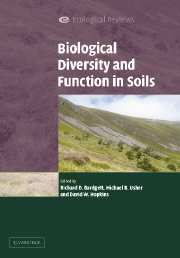Book contents
- Frontmatter
- Contents
- List of contributors
- Preface
- Acknowledgements
- PART I Introduction
- PART II The soil environment
- PART III Patterns and drivers of soil biodiversity
- 5 The use of model Pseudomonas fluorescens populations to study the causes and consequences of microbial diversity
- 6 Patterns and determinants of soil biological diversity
- 7 How plant communities influence decomposer communities
- 8 The balance between productivity and food web structure in soil ecosystems
- 9 Rhizosphere carbon flow: a driver of soil microbial diversity?
- PART IV Consequences of soil biodiversity
- PART V Applications of soil biodiversity
- PART VI Conclusion
- Index
- References
7 - How plant communities influence decomposer communities
Published online by Cambridge University Press: 17 September 2009
- Frontmatter
- Contents
- List of contributors
- Preface
- Acknowledgements
- PART I Introduction
- PART II The soil environment
- PART III Patterns and drivers of soil biodiversity
- 5 The use of model Pseudomonas fluorescens populations to study the causes and consequences of microbial diversity
- 6 Patterns and determinants of soil biological diversity
- 7 How plant communities influence decomposer communities
- 8 The balance between productivity and food web structure in soil ecosystems
- 9 Rhizosphere carbon flow: a driver of soil microbial diversity?
- PART IV Consequences of soil biodiversity
- PART V Applications of soil biodiversity
- PART VI Conclusion
- Index
- References
Summary
SUMMARY
The issue of how plant community composition affects decomposer community composition and function is considered, by reviewing recent literature and through the use of two examples.
It is apparent from the available literature that plant species identity exerts important effects on soil food webs, and that specific attributes such as the body size distribution of soil animals, and the relative importance of bacterial-based vs. fungal-based energy channels, respond to plant species identity. This has important implications for ecosystem functioning.
The first example involves below-ground effects of changes in plant community composition, such as might occur during C4 grass invasion resulting from global warming, in a perennial pasture in New Zealand. The second involves below-ground consequences of changes in vegetation community structure caused by introduced browsing mammals in New Zealand rainforest. Both examples point to above-ground, human-induced changes affecting the composition of the soil food web across several trophic levels, and key ecosystem functions carried out by the soil biota.
The issues of how above-ground biodiversity affects below-ground biodiversity, and the nature of reciprocal feedbacks between the above-ground and below-ground biota, are discussed. It is concluded that understanding the nature of above-ground–below-ground feedbacks may offer opportunities for better understanding how ecosystems function and the ecological consequences of global change phenomena.
Introduction
All functional ecosystems consist of explicit producer and decomposer subsystems. Producers fix atmospheric carbon, which is utilised by the decomposer organisms, and the decomposers in turn break down organic matter, which regulates the availability and supply of nutrients required for plant growth.
- Type
- Chapter
- Information
- Biological Diversity and Function in Soils , pp. 119 - 138Publisher: Cambridge University PressPrint publication year: 2005
References
- 26
- Cited by



